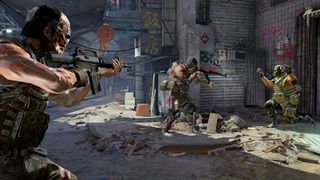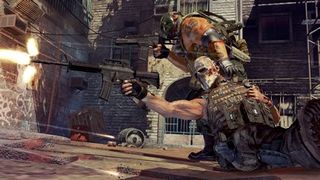Army of Two: The 40th Day – first look
Taking co-op shootouts into the volatile heart of a disaster zone
New mechanics include the mock surrender, where one partner walks out with hands up while the other takes advantage of enemies’ gullibility. Another cool element involves use of GPS trackers – one player can mark targets and hostages, which allows the other player to see the targets through walls. In one scenario we saw, the two players had gotten separated by a car crash. One player encountered a hostage situation that the other player couldn’t see. Once the targets were tagged, the second player could see that they were standing behind a wooden window shutter. This allowed both players to line up headshots on separate targets and execute a simultaneous attack with the second player shooting through the wooden shutter at an enemy he couldn’t otherwise see.

Rios and Salem have been injected with a bit more personality by having them lift up their masks in non-combat situations so you can actually see their faces. More importantly, the player has more control over shaping the personalities. On top of the choices for saving hostages or not, the players can also decide how involved in the 40th day disaster they want to be – it can be all about survival and cash if that’s what suits your fancy. Also new is the ability to negotiate payment for a job – you can demand whatever amount you want, or even ask for no pay at all to show what an ice-bloodedpsycho you are.
The controls aim for a more intuitive and seamless cover system. There is no button to snap to cover – simply approaching cover engages it, and leaving merely requires moving away from it. Sprinting to cover works by just letting go of the stick when you get close, and vaulting over cover happens by simply continuing to sprint. We’re wondering how well the system will work – by the sound if it, it will have advantages and disadvantages compared to the now “default” approach that Gears of War standardized. Without a snap-to button, we can see problems with going into cover when you don’t want to. However, if the details of it are handled smartly and consistently, it could work very well indeed.
Topping things off are the graphical improvements. Character animations are more varied, with bodies reacting more realistically to the environment. The lighting and shadows are more detailed, and the disaster elements happen both in front of your eyes and in “stories” left over in the world around you. The aftermath of destruction isn’t just random broken crap everywhere – you can piece together a sequence of events to how it all happened, which adds a fun element to the disaster feel.

Finally, no details have been given yet, but we know that weapon customization has been expanded, and multiplayer is supposed to be significantly bigger. With those promising improvements added to the list, it’s easy to see how EA has listened to the feedback from the original game and taken on just about every complaint there was. The multiplayer especially sounds tantalizing, so we’re hoping to hear more about it soon.
Mar 16, 2009
Sign up to the GamesRadar+ Newsletter
Weekly digests, tales from the communities you love, and more
Most Popular



